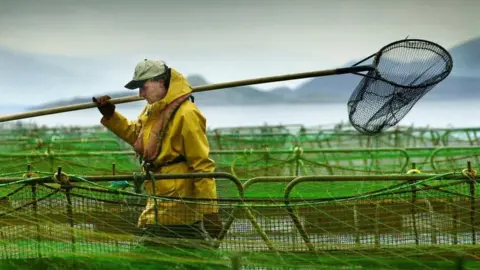Salmon farms struggle with 'biological' problems
 Getty Images
Getty ImagesSome of Scotland's biggest salmon farms have reported significant and continuing "biological"' problems.
That often refers to sea lice or disease and there has also been a challenge from exceptionally high sea temperatures, bringing more jellyfish.
Leroy, the Norwegian firm that owns half of Scottish Sea Farms, said April to June was "extremely challenging" .
It reported problems on its fish farms have affected average harvest size.
Salmon farmers often have to harvest fish before they have grown to full size if there is an infestation of lice, bringing higher costs and lower prices.
Leroy reported its Scottish operations brought a cost of £13.2m in "incident-based mortality".
That can mean the destruction of fish stocks if they are diseased and cannot be put on the market.
Scottish Sea Farms have revised their estimated full-year output to 27,000 tonnes, having produced 38,000 tonnes over the whole of 2022.
Leroy reported a £4.8m (65m kroner) loss on Scottish Sea Farms in the second quarter, after a £5.2m (70m kroner) profit for the same period last year.
"This development can be attributed to a challenging biological situation," it reported. "Gradual improvement is expected through the second half this year."
Scottish Sea Farms declined to comment further ahead of its other co-owner, Salmar, issuing a market update.
 PA
PA'High temperatures'
Financial results looked better at Mowi, the world's biggest salmon farmer, also based in Norway.
It said operational pre-tax earnings in Scotland doubled the level reached in the second quarter of last year, and the harvest rose from nearly 13,000 tonnes to 18,300 tonnes in April to June this year.
The industry benefited from a big rise in prices during this year, with spot prices up by around 70% in the past two years, but with feed costs up as well.
"Incident-based mortality" on its Scottish sites cost Mowi 2.7m euros (£2.3m).
Its market update said "biological performance was relatively good, especially taking into consideration the record high seawater temperatures (in June).
"High temperatures caused some feeding issues due to the challenges of storing and handling feed in such high air temperatures. These also led to more challenging environmental conditions related to increased presence of plankton, algae and jellyfish".
'Biological risks'
At Bakkafrost, headquartered in the Faroes and with an extensive presence in the west of Scotland, financial figures improved on tough conditions in 2022.
A statement explained: "In Scotland, there have been some challenges in one farming area, but not as severe as in previous quarters. This demonstrates that the biological risks are still high."
To reduce risk to salmon while in sea cages, Bakkafrost is building large tanks for growing young salmon, or smolts, to a bigger size before being transferred, than in the past. One of these is under construction at Applecross in Wester Ross.
Chief executive Regin Jacobsen said: "Bakkafrost's strategy to implement large smolt in Scotland is key to reducing the biological risk and improving biological performance. Building hatchery capacity in Scotland is, therefore, the topmost priority for Bakkafrost."
Major growth
Scottish salmon export sales jumped by 9% in the first half of 2023, with major growth in the Asian and American markets.
New figures show that salmon from Scotland, which is the UK's largest food export, recorded a value of £306m between January and June.
The largest increases by value were to the USA, China, Poland and Taiwan, while there was also huge percentage growth in the Netherlands, Singapore, Japanese and Spanish markets.
France remains by far the top international destination for Scottish salmon, and although sales to the country dipped 5% in the first half of the year, this was more than offset by wider global demand.
